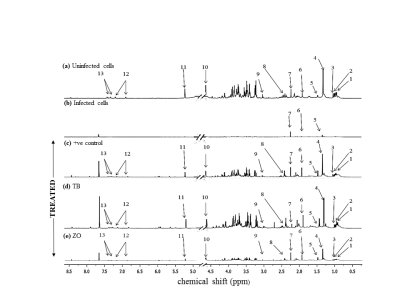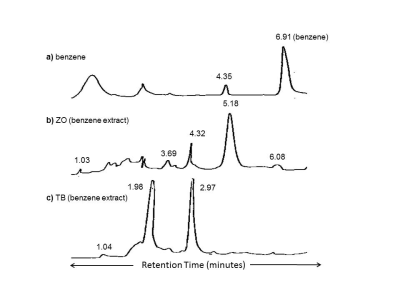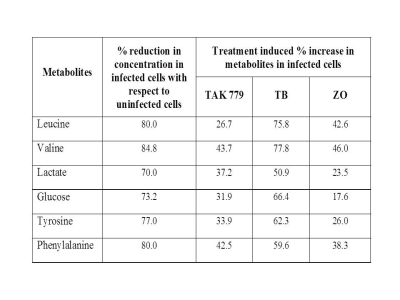4010
In vitro screening of drug response in HIV-1 pseudovirus infected cells using NMR1Department of NMR, All India Institute of Medical Sciences, New Delhi, India, 2Department of Biochemistry, All India Institute of Medical Sciences, New Delhi, India, 3Department of Ocular Pharmacology & Pharmacy, All India Institute of Medical Sciences, New Delhi, India
Synopsis
There is a necessity for novel and quick drug response screening methods for providing lead information for drug discovery. In this context, NMR can be a potential screening method. This study has used proton NMR spectroscopy for drug response in HIV-1 psuedovirus infected TZM-bl cells after treatment with TAK 779 (positive control), and benzene extracts of Terminalia bellerica and Zingiber officinale. Significant reduction in metabolites was observed in infected cells and metabolites were subsequently restored closer to normal levels on treatment with positive control and plant extracts. The study has demonstrated NMR to be a quick screening method for drug response.
Introduction
An estimated 36.7 million people worldwide are affected with HIV/AIDS, making it a major global health problem. In such a scenario, a combination of drug toxicity and resistance has made search for new anti-HIV agents, in particular plant-based, a research priority.1 However, drug discovery is a long and challenging process with a number of important steps, one being in vitro screening of drug response2. This study has explored the potential of proton NMR spectroscopy for quick screening of drug response in plant extracts treated HIV-1 pseudovirus infected cells.Materials and Methods
Samples: Based on prior evaluation of anti-HIV-1 activity using neutralization assays, benzene fractions of Terminalia bellerica (TB) and Zingiber officinale (ZO) were selected for the study. Three sets of samples were studied: (i) uninfected TZM-bl cells (ii) TZM-bl cells infected with HIV-1 pseudovirus (iii) infected cells treated with +ve control (TAK 779), TB and ZO. Molecular clones of HIV-1 envelope, which can cause only a single round of infection in the cells, were used to produce a safe model for assessing the entry level blocking in this study.
Anti-HIV-1 neutralization assay: Using predetermined IC50
values, 200 TCID50 of Clade C pseudovirus was pre-incubated with
each of the drug (TAK 779, ZO and TB extracts) separately in a 96-well
flat-bottom culture plate for 1hr at 37ºC and 5% CO2. TZM-bl cells (n=10,000)
were then added to each well. After 48 hours of incubation, cells were
extracted using chloroform:methanol (1:2) solvent, vortexed and centrifuged.
The supernatant was collected and lyophilized. In addition, High Pressure
Liquid Chromatography (HPLC) was used to analyze the extracts for remnant benzene
(extraction solvent). The objective was to rule out contribution to anti-HIV-1
activity from remnant benzene, if any in the plant extracts.
NMR: The lyophilized powder was dissolved in 600μl of D2O. Water suppressed 1D proton NMR spectra were acquired at 700 MHz (Agilent, USA): relaxation delay - 14 sec, scans - 256, spectral width - 12 ppm, data points - 32 K. Deuterated TSP in a coaxial insert was used as an external reference. Peak assignments were carried out using NMR data libraries.3, 4 Using TSP as reference, concentration (mM) of metabolites were determined and their percentage changes calculated.
Results
The NMR spectrum of TZM-bl cells (Fig. 1a) showed resonances from a number of amino acids: straight chain (alanine), branched (leucine, isoleucine and valine) and aromatic (tyrosine, phenylalanine), and also other metabolites like glucose, lactate, acetate and creatine associated with energy metabolism. Infection by HIV-1 pseudovirus caused significant reduction in metabolite levels (Fig. 1b) compared to that in uninfected cells (Fig 1a): leucine (80%), valine (85%), glucose (73%), tyrosine (77%) and phenylalanine (80%). Treatment by positive control (TAK 779) and plant extracts restored the metabolite levels closer to that of normal cells, indicating positive response to treatment (Figs. 1c-1e). Table 1 shows the % changes in the metabolites after HIV-1 infection and subsequent treatment with +ve control and benzene plant extracts. It is interesting to note that Terminalia bellerica induced restoration of metabolites better than that by the positive control drug. Figure 2 shows the HPLC chromatograms of benzene (Retention time = 6.9 min), TB and ZO extracts. Benzene was not observed in the extracts of ZO and TB, confirming the anti-HIV-1 activity to be solely due to the plant extracts and ruling out that by remnant solvent.Conclusion
The necessity to discover new anti-HIV-1 medicines, with better therapeutic efficacy and minimum adverse effects, has renewed interest in exploring the therapeutic potential of medicinal plants. However, the huge cost and time involved in drug discovery can be offset by quick in vitro screening methods, especially for natural products. In this context, this study has shown that NMR can provide a quick and efficient screening method for evaluation of drug response.Acknowledgements
No acknowledgement found.References
1. Ensoli B, Cafaro A, Monini P, et al. Challenges in HIV vaccine research for treatment and prevention. Front Immunol. 2014; 5: 1-11.
2. Mundae MK, Ostör AJ. The long road of biopharmaceutical drug development: from inception to marketing. The Quaterly J Med. 2010; 103: 3-7.
3. Wishart DS, Jewison T, Guo AC, et al. HMDB 3.0 - The Human Metabolome Database in 2013. Nucleic Acids Res. 2013; 41: D801-807.
4. Deborde C and Jacob D. MeRy-B, a metabolomic database and knowledge base for exploring plant primary metabolism. Methods Mol Biol. 2014; 1083: 3-16.
Figures


